| Family Recipes
Nonna's Cheese Cake
On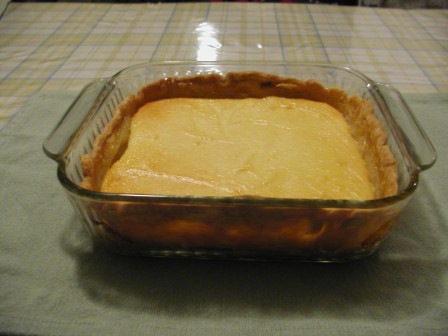 e of our family's favorites is a "cheese pie" made with ricotta that is traditionally made and served at Easter time. This recipe originates in the Sorrento region of Italy where lemons are grown on trees lining the streets and in every backyard. The lemons are used in every day cooking and to make Limoncello, a very potent liqueur. e of our family's favorites is a "cheese pie" made with ricotta that is traditionally made and served at Easter time. This recipe originates in the Sorrento region of Italy where lemons are grown on trees lining the streets and in every backyard. The lemons are used in every day cooking and to make Limoncello, a very potent liqueur.
A two pound container of your favorite brand of ricotta will make two cheese pies -- one to enjoy and one for the freezer.
Prepare standard pastry crusts for the bottom of two glass pie plates.
Meanwhile, put the ricotta into a large bowl. Add two large eggs, one cup of sugar and the zest and juice of one large lemon or even more if you love the taste of lemon. Add a little milk, not too much, and mix well.
Pour the mixture into the pie plates and bake in a pre-heated 325 degree oven. Bake for about one hour until the pie filling is set and the crust a golden brown. As ovens differ, I recommend checking on the pies after a half hour or so to judge the baking time.
Let the pies cool thoroughly before refrigerating until served.
Buon appetito!
Nonna's Stuffed Artichokes
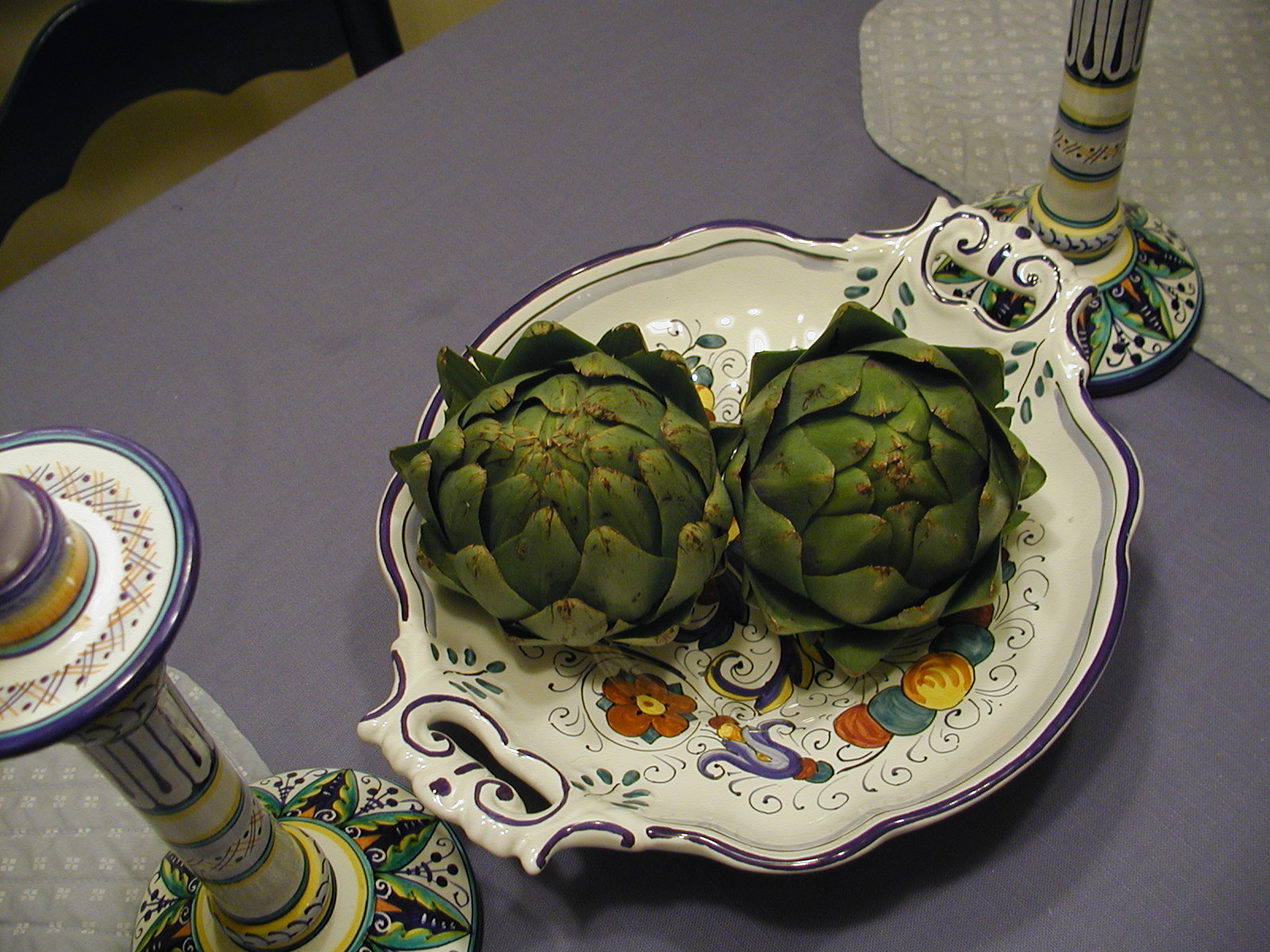 Many cooks would be daunted by the prospect of preparing stuffed artichokes, but they are an elegant vegetable that would delight both the cook who is brave enough to tackle them as well as the diner who would enjoy eating one of the most enduring contributions to the cuisine of the world. Many cooks would be daunted by the prospect of preparing stuffed artichokes, but they are an elegant vegetable that would delight both the cook who is brave enough to tackle them as well as the diner who would enjoy eating one of the most enduring contributions to the cuisine of the world.
I can't resist a little history about the artichoke. A member of the thistle family, the artichoke has been cultivated in the Mediterranean region since . . . well, practically forever. Cynara Scolymus, that's the Latin designation, began its long journey in the Middle East, as so many of the world's cultivars, because that's where agriculture as we understand it first began. The artichoke on our tables is the flower of the plant introduced to ancient Greece and Egypt. It made its way onto the ancient Roman table and from there spread to France (ancient Gaul). The French are as dotty as the Italians about artichokes; nothing is as much fun as exploring a vegetable market in Italy, so if you travel there, make a point of visiting one. In Italy, they especially love the tender little artichokes and prepare them in a multitude of ways. In some regions they are stuffed with meat; in others, with bread and cheese.
As a child, I learned to enjoy artichokes (I'm reminded of the "Little Rascals" scene where Spanky and the gang are presented with artichokes, and Buckwheat says "They mighta choked Arty, but they ain't gonna choke me." Spanky and the rest nodded sagely.), but picture me as a little girl gamely scraping the leaves of the cooked artichokes with my teeth and watching the adults at the table doing the same. It's part of family.
Our family originated in the Regione di Campania, and around Naples, the stuffing is of the bread and cheese variety, and that's what the recipe that follows is all about.
To start, buy fresh bright green artichokes at your store that are fleshy and plump. They should smell good and be firm to the touch. When you get them home, store them in the fridge until you are ready to cook them. To prepare them to be stuffed, first cut off the remnants of the stalks so that they will sit upright on your kitchen counter. Remove any dark tough leaves around the base and trim the tips of the leaves with a scissor. Next, cut off the top about 1/2" so that they are straight across.
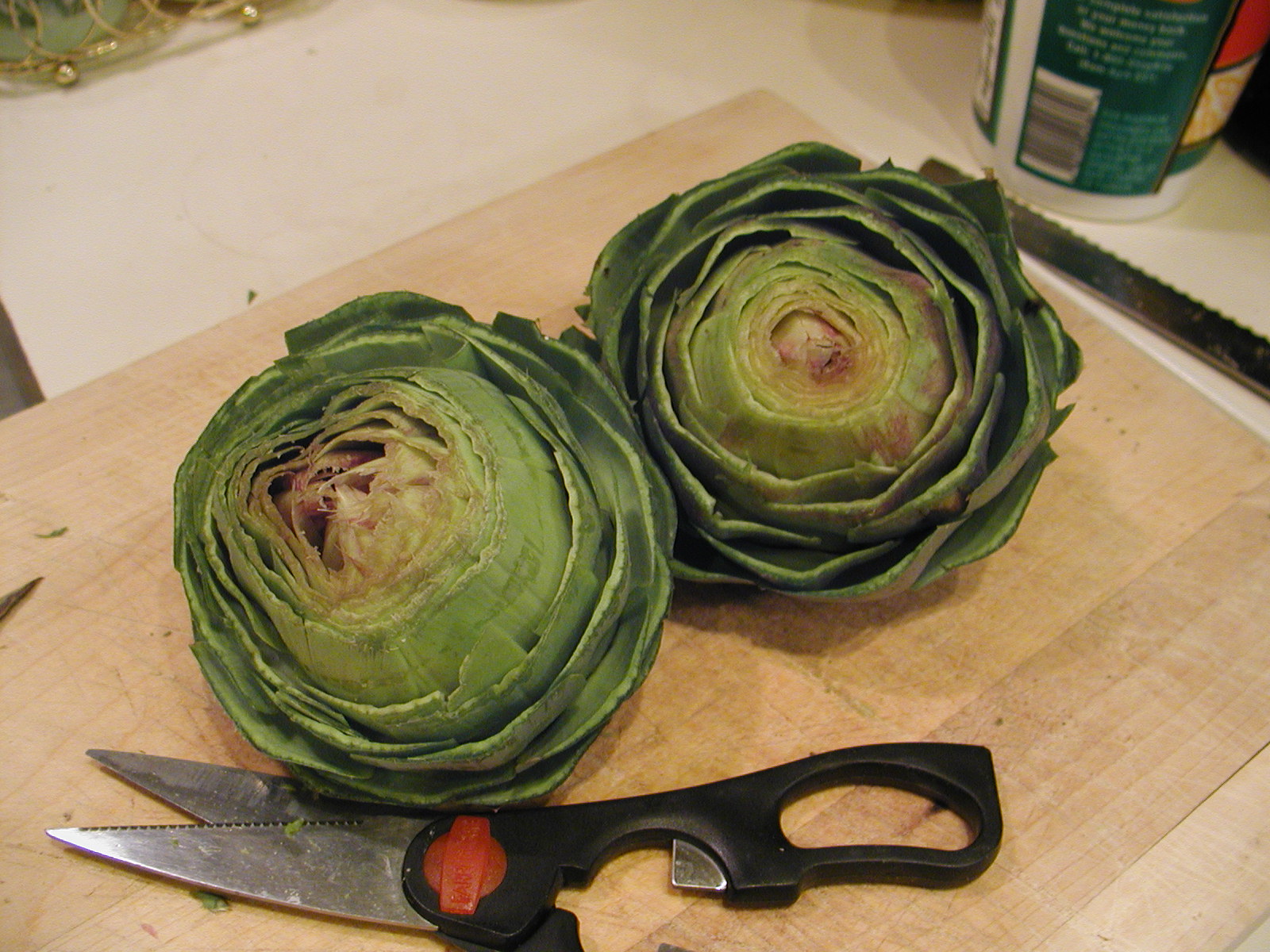 Rinse the artichokes in the sink under cold water and invert them bottom up in a bowl of water while you prepare the stuffing. You will need a large pot with enough room to fit the artichokes without crowding. The size of the pot depends on how many artichokes you are making (I usually make four at a time because they keep in the fridge covered for a couple days, so you can have two at dinner and two at another meal). Rinse the artichokes in the sink under cold water and invert them bottom up in a bowl of water while you prepare the stuffing. You will need a large pot with enough room to fit the artichokes without crowding. The size of the pot depends on how many artichokes you are making (I usually make four at a time because they keep in the fridge covered for a couple days, so you can have two at dinner and two at another meal).
Now to the best part -- the stuffing:
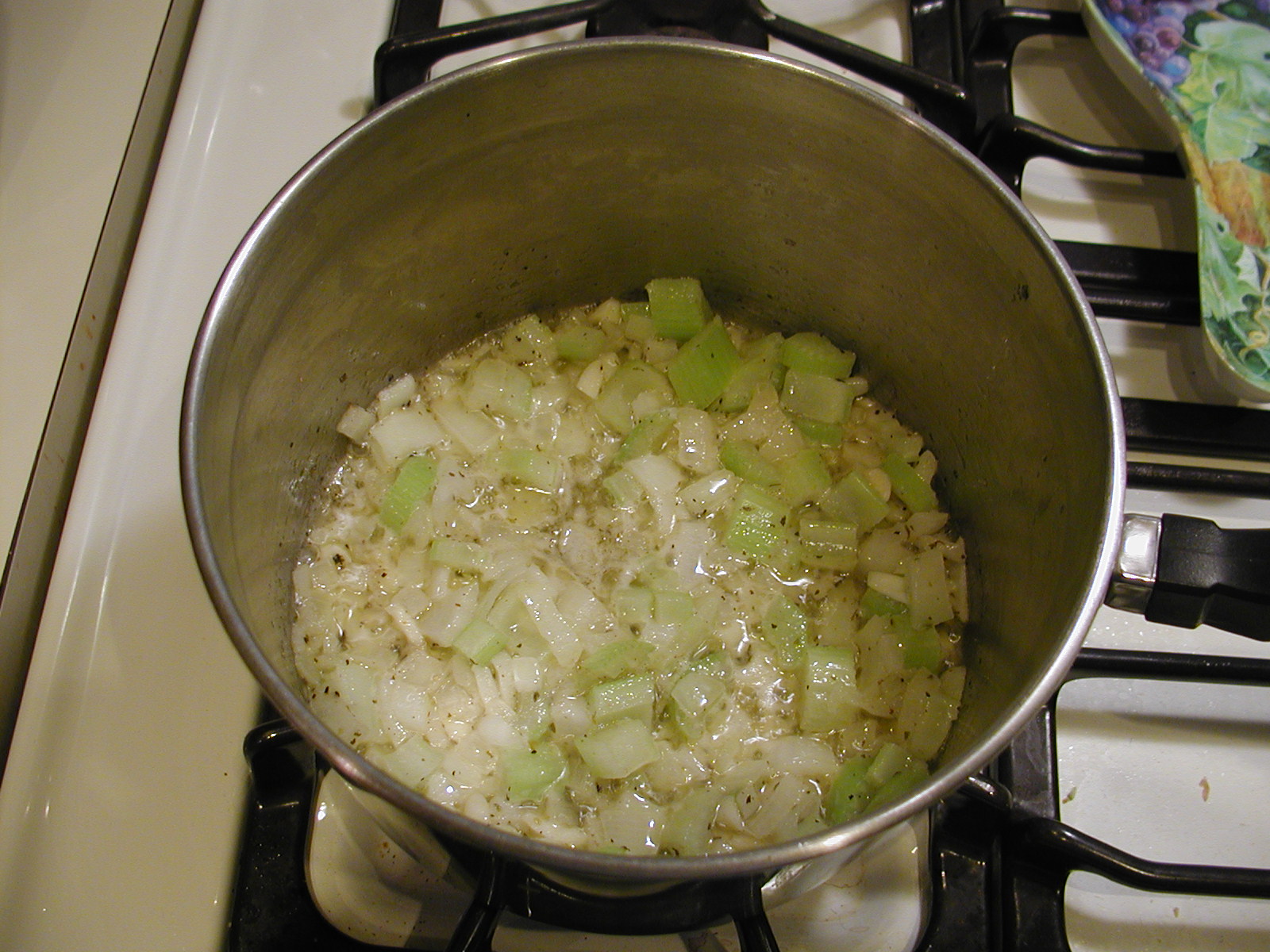 Dice up one onion (size depends on number of artichokes) Dice up one onion (size depends on number of artichokes)
Dice up a celery rib (again, could be two ribs)
Saute in 1 or 2 tablespoons of butter until tender.
In a separate bowl, use up any bread you have on hand by breaking it into pieces. This can consist of the heels of bread, stuffing cubes, Italian bread cut up, etc. You may supplement your bread for stuffing with Italian-style bread crumbs.
Add two heaping tablespoons of ricotta cheese, one large egg (to bind), grated cheese (Romano, Parmesan, whichever you prefer), and seasoning to taste -- fresh ground pepper, dry or fresh basil, Italian parsley, garlic powder -- which can only enhance your stuffing mixture.
Then add the onion/celery to the bowl and mix thoroughly. Adjust the bread or egg until the mixture's consistency is workable.
Spread open the tops of the artichokes and with a large spoon cram in as much stuffing as each will hold.
Put the artichokes into the pot with about an inch of water; drop in a roughly cut clove of garlic and a few drops of VOO.
Put the gas on at medium and lower to a simmer when the water starts to bubble. Tilt a lid on the pot so steam escapes and check to make sure the water doesn't cook away. Add more as needed. The artichokes cook until a fork inserted in the center goes through easily. Pull off the leaves and scrape the inside of the leaf with your bottom teeth. When you reach the choke, be extra careful to scrape it out to get to the heart. Eat and enjoy!
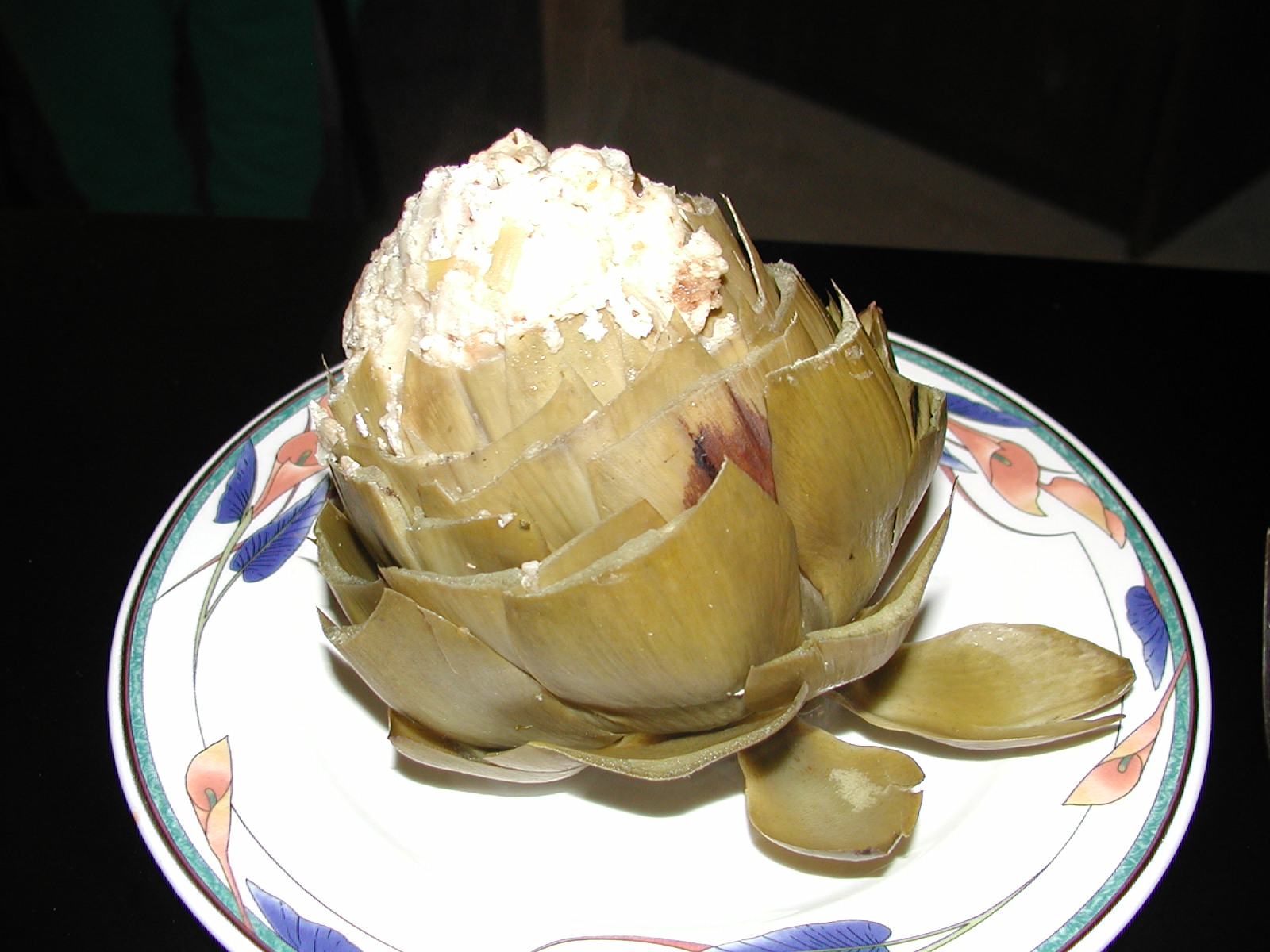
|
